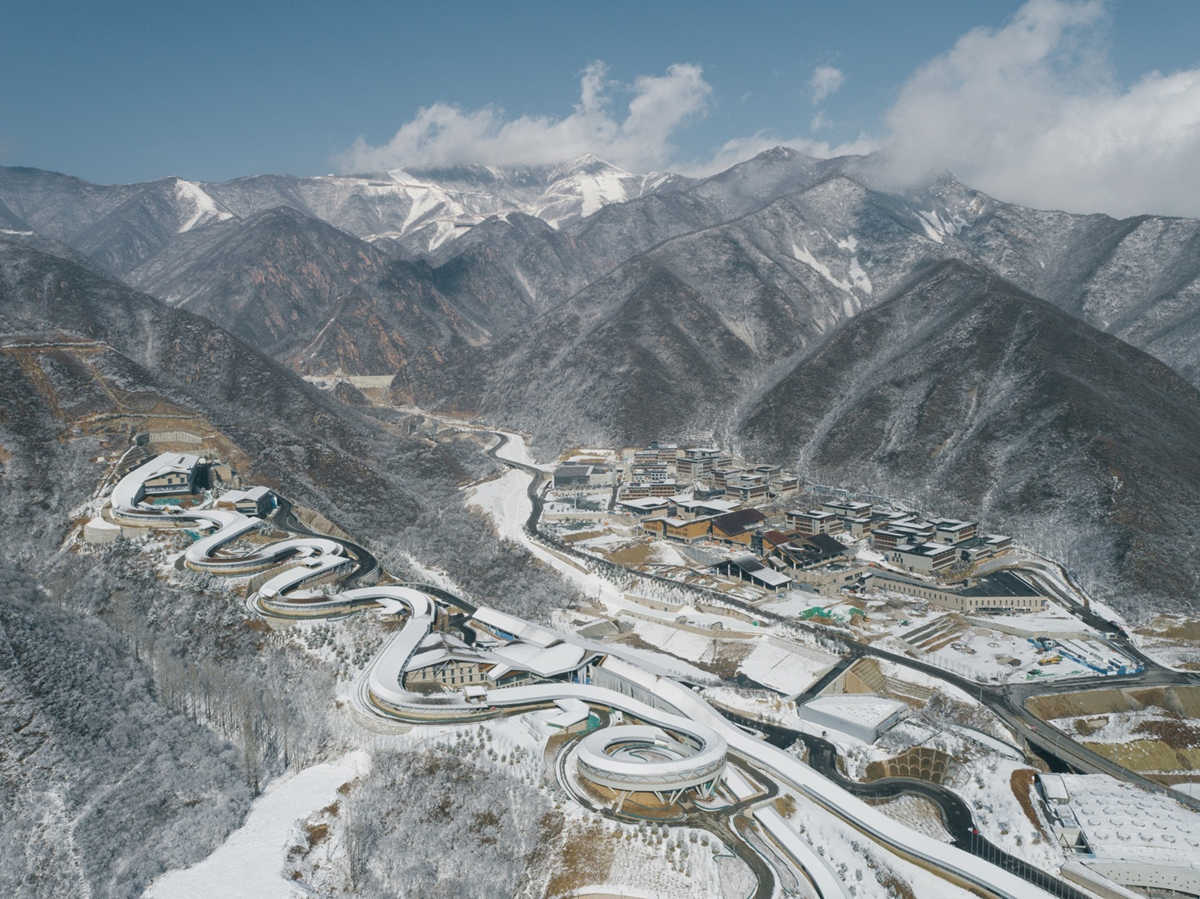Improving the Mountains through Sustainable Olympics

The National Snowmobile and Sled Center, nicknamed the “Flying Snow Dragon,” is unique in the world in its seamless integration with the natural landscape, according to Christoph Schweiger, executive director of the International Luge Federation, when he inspected Yanqing District before the opening of the Beijing 2022 Olympic Winter Games. The venue has withstood the test of the Games and offered an “extraordinary experience” to riders from around the world.
Li Xinggang, chief designer of the Yanqing competition zone (one of the three main venue clusters for the 2022 Winter Olympics), clearly realized his design philosophy of achieving “harmony between sports and ecology.” Li was the head of the Chinese portion of the design team for Beijing’s National Stadium, also known as the Bird’s Nest, built for the 2008 Beijing Olympics. He summarized his previous projects as embracing a design philosophy of buildings integrating with nature while being innovative, state-of-the-art, and embellished with unique Chinese features. The venues built in high mountains and dense forests of Yanqing, set to become high-quality, professional venues for top sporting events, provided Li a wonderful opportunity to put his philosophy into practice. The opportunity to design mountain venues for a sustainable Olympic Games was the most ideal assignment he could have ever hoped for.

Li Xinggang displays a design drawing. The chief designer of the Yanqing competition zone was also head of the Chinese section of the design team for Beijing’s National Stadium, also known as the Bird’s Nest, built for the 2008 Beijing Olympics. by Zheng Liang
Li soon found two main challenges in planning and designing the venues in Yanqing. The first was finding a way to improve the environmental quality and achieve ecological, economic, and social sustainability after introducing a massive construction project to the dense forests and deep valleys of the Haituo Mountains. The second was ensuring the venues met Olympic standards while maintaining unique Chinese characteristics.
Li and his team, however, leveraged the challenges and made them highlights. For example, inspired by traditional dwellings in southwestern China, Li chose a raised structure in the design for the National Alpine Ski Center to minimize the disturbance to the mountainous landscape. Unnecessary buildings were made to be dismantled after the Games and the original ecology restored. The National Snowmobile and Sled Center was another pristine example of adapting to the surrounding terrain to protect the ecological environment.
Li always seeks to inject traditional Chinese cultural elements into his architecture designs, from the Bird’s Nest to the Olympic venues in Yanqing. The National Alpine Ski Center and the National Snowmobile and Sled Center were poetically dubbed “Flying Snow Swallow” and “Flying Snow Dragon” respectively by locals due to their appearances.

The sketch of the National Alpine Ski Center drawn by Li Xinggang when he investigated the site on June 16, 2017. courtesy of Atelier Li Xinggang
The track of the ski center features a maximum vertical drop of 900 meters, and the slope stretches about 3,000 meters. From a distance, the venue looks like a swallow with outspread wings. The starting zone of the ski center is half-embedded in the mountain, and the buildings are at the same height or slightly lower than the summit. This conforms to the traditional Chinese cultural value of harmony between man and nature. “The buildings within the starting zone must be shorter than 2,198 meters—that’s the altitude of the summit of Xiaohaituo Mountain,” said Li Xinggang. “It shows designers’ respect for nature.”
The weather conditions in the Yanqing competition zone are harsh in winter, with the lowest temperature on the top of Xiaohaituo Mountain reaching minus 40 degrees Celsius. Li noted that the buildings on the mountaintop withstood 14-scale winds occurring early in 2021 and the structure remained stable with only a few wooden roof tiles slightly coming loose. The secret was that the designer surrounded the starting zone on three sides by slopes, instead of putting it on the top of the mountain, to utilize the mountain slopes as protective shields. “Modern construction technology helps the buildings resist strong winds, but traditional Chinese culture played a decisive role in determining the ideal location,” he said. “Staying humble and respecting nature reflect ancient Chinese wisdom on living in harmony with nature.”

A 3D display of the National Snowmobile and Sled Center and the Winter Olympic Village in Yanqing District, Beijing. courtesy of Atelier Li Xinggang
The National Snowmobile and Sled Center is a feast for the eyes. The tracks resemble a dragon winding from north to south along a ridge west of the Yanqing competition zone’s entrance. The north slopes of the Haituo Mountains are too steep to compete, while the south-facing slopes are susceptible to sunlight. “We developed a system protecting the snow surface of the track from various weather conditions such as solar radiation to minimize energy consumption,” Li said.
Unlike previous Winter Olympic villages that brought tall buildings into cities or mountains, Yanqing Winter Olympic Village was built north-south along the terrain to be consistent with local traditional mountain villages and retains the greatest variety of native trees. Nestled snugly in the Winter Olympic Village is a village ruin dating back to the 1940s with mottled walls, stacked stones, and old trees. It now serves as a park providing an important public space for the Winter Olympic Village. “Mountain villages, old trees, and ruins define the style of the venue to some extent,” Li said. “Athletes from all over the world got a taste of Chinese mountain villages during their stay in the Winter Olympic Village.”
“My sketches transformed into beautiful, large-scale, and sustainable Olympic venues in the Haituo Mountains,” Li beamed. “Harmony between sports and ecology is the new driver of design and construction of Olympic venues under the concept of sustainable development, and it is the common pursuit of mankind seeking a better future.”